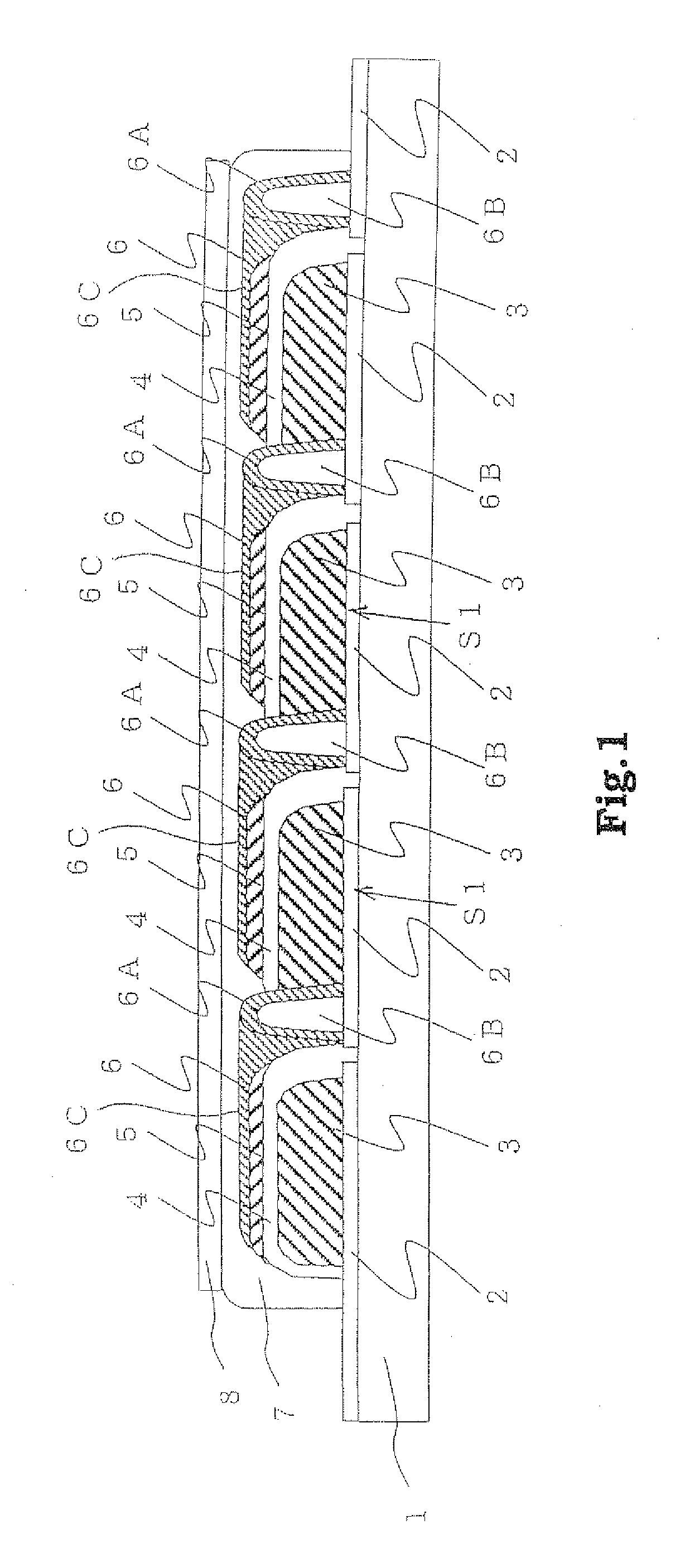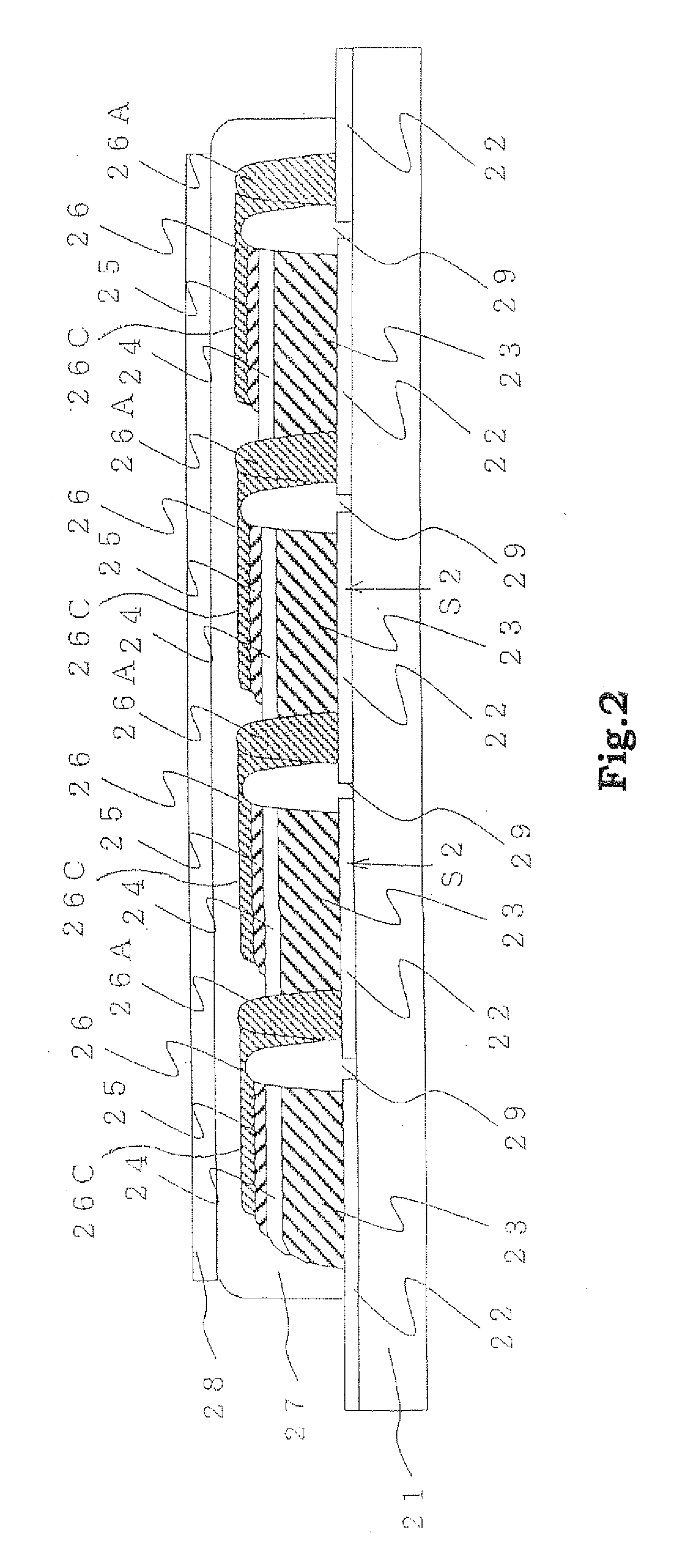Dye-sensitized solar cell module and method of producing the same
a solar cell module and dye sensitization technology, applied in the direction of cell components, final product manufacturing, sustainable manufacturing/processing, etc., can solve the problems of high production cost of silicon substrates, increase production costs, and above-mentioned problems that remain unsolved, and achieve the effect of improving the density of module output curren
- Summary
- Abstract
- Description
- Claims
- Application Information
AI Technical Summary
Benefits of technology
Problems solved by technology
Method used
Image
Examples
embodiment 1
[0119]FIG. 1 is a schematic sectional view showing a constitution of Embodiment 1 of the dye-sensitized solar cell module of the present invention.
[0120]The dye-sensitized solar cell module of Embodiment 1 is composed of a plurality of electrically series-connected solar cells S1 having a transparent insulating substrate 1, a transparent first conductive layer 2 formed on the insulating substrate 1, a photoelectric conversion device obtained by forming a photoelectric conversion layer 3 comprising a porous semiconductor layer adsorbing a dye, a carrier transporting layer 4 and a catalyst layer 5 subsequently on the first conductive layer 2, and a second conductive layer 6 formed on the photoelectric conversion device, wherein all of a plurality of cells S1 are covered with a sealing layer 7 and a cover film 8 is laminated on the sealing layer 7. In addition, existence of transparency of the sealing layer 7 and the cover film 8 is not particularly restricted.
[0121]Structural features...
embodiment 2
[0126]FIG. 2 is a schematic sectional view showing a constitution of Embodiment 2 of the dye-sensitized solar cell module of the present invention.
[0127]In the same manner as in Embodiment 1, the dye-sensitized solar cell module of Embodiment 2 is composed of a plurality of series-connected solar cells S2 having a transparent insulating substrate 21, a transparent first conductive layer 22 formed on the insulating substrate 21, a photoelectric conversion device obtained by forming a photoelectric conversion layer 23 comprising a porous semiconductor layer adsorbing a dye, a carrier transporting layer 24 and a catalyst layer 25 subsequently on the first conductive layer 22, and a second conductive layer 26 formed on the photoelectric conversion device, wherein all of a plurality of cells S2 are covered with a sealing layer 27 and a cover film 28 is laminated on the sealing layer 27.
[0128]Structural features of this solar cell module of Embodiment 2, differing from those of Embodiment...
embodiment 3
[0132]FIG. 3 is a schematic sectional view showing a constitution of Embodiment 3 of the dye-sensitized solar cell module of the present invention.
[0133]In the same manner as in Embodiments 1 and 2, the dye-sensitized solar cell module of Embodiment 3 is composed of a plurality of series-connected solar cells S3 having a transparent insulating substrate 31, a transparent first conductive layer 32 formed on the insulating substrate 31, a photoelectric conversion device obtained by forming a photoelectric conversion layer 33 comprising a porous semiconductor layer adsorbing a dye, a carrier transporting layer 34 and a catalyst layer 35 subsequently on the first conductive layer 32, and a second conductive layer 36 formed on the photoelectric conversion device, wherein all of a plurality of cells S3 are covered with a sealing layer 37 and a cover film 38 is laminated on the sealing layer 37.
[0134]Structural features of this solar cell module of Embodiment 3, differing from those of Emb...
PUM
| Property | Measurement | Unit |
|---|---|---|
| thickness | aaaaa | aaaaa |
| temperature | aaaaa | aaaaa |
| thickness | aaaaa | aaaaa |
Abstract
Description
Claims
Application Information
 Login to View More
Login to View More - R&D
- Intellectual Property
- Life Sciences
- Materials
- Tech Scout
- Unparalleled Data Quality
- Higher Quality Content
- 60% Fewer Hallucinations
Browse by: Latest US Patents, China's latest patents, Technical Efficacy Thesaurus, Application Domain, Technology Topic, Popular Technical Reports.
© 2025 PatSnap. All rights reserved.Legal|Privacy policy|Modern Slavery Act Transparency Statement|Sitemap|About US| Contact US: help@patsnap.com



